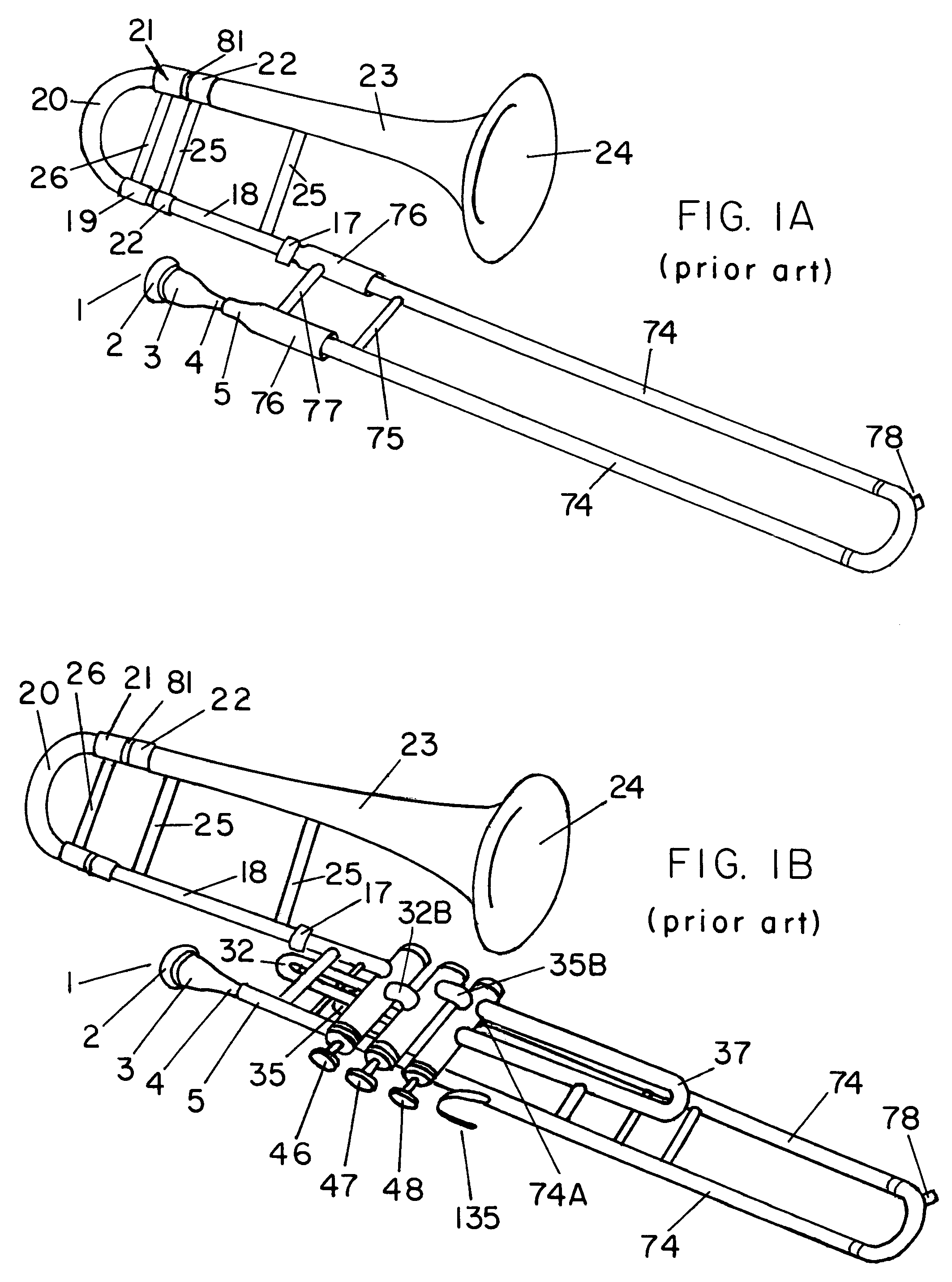Gradually progressive bore BB-flat, CC, E-flat, F, or B-flat valved musical wind instrument and valved B-flat/F inverted double musical wind instrument
a musical wind instrument and progressive technology, applied in the field of low brass musical wind instruments, can solve the problems of affecting tone quality and particularly in the lower performing octaves, the slide of the trombone is more awkward to move, and the valve trombonist can often execute technically difficult passages more quickly, so as to reduce the internal surface area, smooth the effect of action, and reduce friction
- Summary
- Abstract
- Description
- Claims
- Application Information
AI Technical Summary
Benefits of technology
Problems solved by technology
Method used
Image
Examples
first embodiment
[0173]FIG. 15A shows a non-limiting first example of the first embodiment BB-flat Tu-Bone with the at least three and preferably four rotary valves (7a), but with valve tubing loops truncated and valve keypads, and rotary linkages removed to facilitate a simplified inspection of the main approximately 216 inch BB-flat path (5, 6, 8, 29, 9–18, 20, 23, 24) which is the only active air path with no valves (7a) engaged. The radical difference in the limited (limited to 0.850 inch maximum bore) progressive cylindrical mid-section tubing bore or gradual conical mid-section bore expansion, or combination of limited progressive cylindrical and gradual conical mid-section bore expansion of the invention BB-flat Tu-Bone over a preferred majority of its main path length may be seen, relative to the significantly more rapid conical bore expansion of a BB-flat tuba, by comparing FIG. 15A with FIG. 11B. The small bell throat (23) diameter of the invention Tu-Bone, relative to the tuba may also be...
fifth embodiment
[0198]In the fifth embodiment, air may proceed sequentially through valves V1–V4 (46–49), beginning with V1 (46) in a nonlimiting example, and this is preferred for “early” placement of the valve section in a nonlimiting example as seen in FIG. 22A. Alternatively, air may proceed in reverse sequence from V4 (49) to V1 (46), prior to exiting to the bell section in a nonlimiting example, and this is preferred for “late” placement of the valve section in a nonlimiting example, as seen in FIG. 22B. Either of these placements and directionalities, and even their less preferred vice-versa combinations (V1–V4 progression in late placement and V4–V1 progression in early placement, neither of which are shown in figures) are all within the scope of the invention.
[0199]With no valves engaged, the fifth embodiment path length is 108 inches and the fundamental musical pitch (key) is B-flat. Referring to FIGS. 22A–B, engaging valve 2 (V2, 47) alone adds loop 34–36 to the path which lengthens the ...
sixth embodiment
[0208]In the sixth embodiment, the B-flat inverted double Tu-Bone may have the change of “story” occurring via tubing routing external to the valves as in FIG. 23A with V4 (49) designed as in FIG. 23B, such that external B-flat tubing (7, 50–52), which is active without V4 (49) being engaged, directs air from a lower level V4 (49) valve exit port (7A) to an upper level entry port of another valve V1 (7B) and ultimately from an upper level V3 exit port (52) returning to an upper level V4 entry port (52) prior to upper level V4 exit (53) in the B-flat disengaged first of two V4 (49) operating positions, and such that the external F tubing (54–57), which is active whenever V4 (49) is engaged, moves diverts air from a second lower level V4 valve port (54A) to a lower port of V1 (54B) and ultimately from a lower level V3 exit port (57A) returning to a second upper level V4 entry port (57B) in the F engaged first of two V4 (49) operating positions.
[0209]Alternatively, V4 may have an air p...
PUM
 Login to View More
Login to View More Abstract
Description
Claims
Application Information
 Login to View More
Login to View More - R&D
- Intellectual Property
- Life Sciences
- Materials
- Tech Scout
- Unparalleled Data Quality
- Higher Quality Content
- 60% Fewer Hallucinations
Browse by: Latest US Patents, China's latest patents, Technical Efficacy Thesaurus, Application Domain, Technology Topic, Popular Technical Reports.
© 2025 PatSnap. All rights reserved.Legal|Privacy policy|Modern Slavery Act Transparency Statement|Sitemap|About US| Contact US: help@patsnap.com



